 |
 |
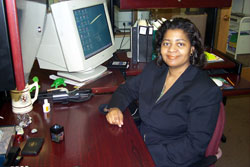
|
|
Crystal Smith, Medical Library Technician, History of Medicine Division, National Library of Medicine, Bethesda, Maryland
|
1. I chose this career because...
2. My Work History...
3. My typical workday involves...
4. What I like best and least about my work is…
5. My career goals are...
6. When I'm not working, I like to...
|
|
1. I chose this career because...
|
Back to Top

|
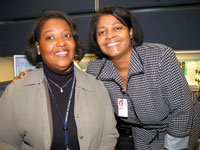
|
|
Crystal Smith with her mentor, Lorretta Turnage.
|
I chose to become a library technician because of my early work experiences, and because my mentor encouraged me to pursue my goal.
Education
- Associate of Arts, General Studies, Montgomery College, Rockville, Maryland
- Bachelor of Arts, History, Concentration Health Education, University of Maryland at College Park, Maryland
- Master of Library Science, College of Information Studies, University of Maryland at College Park, Maryland
- Certification, State of Maryland’s Library Associate Training Program
|
|
2. My Work History...
|
Back to Top

|
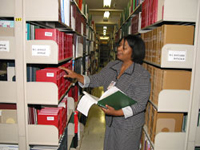
|
|
Crystal Smith checks references and retrieves books for NLM patrons.
|
First Job - Library Assistant
For my first job after high school, I worked in a public library as a library assistant. I was responsible for transferring books and other materials between libraries inside and outside of the county. I also helped with clearing out old titles, selecting new titles to order and display, filing, and answering telephone inquiries. Some time later, I started a family and temporarily left the workforce.
At the National Library of Medicine (NLM) (http://www.nlm.nih.gov/)
When my daughter was a little older, I began working for NLM as a library technician. At NLM I have rotated through different divisions of the library, including the Public Services Division, the Technical Services Division, Bibliographic Services Division, and the History of Medicine Division. These diverse experiences have given me a great perspective on all aspects of running a library, particularly NLM.
In the Public Services Division, I worked in the Collection Access Section (CAS). CAS is a collection of more than 6 million items including journals, books, technical reports, manuscripts, microfilms, photographs and images. We help health and science professionals access these materials through a variety of ways. When I worked in this section, I retrieved books for health care professionals, medical researchers, and others who requested NLM resources. I also photocopied journal articles for interlibrary loans, nationwide and internationally.
In the Technical Services Division, I worked in the Selections Acquisitions Section (S & A). S & A orders all the books, and other published materials for the NLM collection, the staff library, and for individuals. As a technician, I was responsible for receiving the new materials, and processing them. The process involved checking the invoices for accuracy, imputing the information into our collection database, putting labels on the books, and getting them ready to go on the shelf. This is a very detailed and analytical task. You must make sure everything matches – orders, invoices, and titles received.
My Mentor
While working in S & A, I discussed my career path with my supervisor/mentor, who is a librarian. I expressed my interest in library work, especially the problem solving, analytical, and research aspects of the job. I asked her advice about the education I needed to reach my goal of becoming a professional librarian. She encouraged me to get an undergraduate degree first, and then apply to a library program. She felt that this was the best course of action to take.
Back to School
I followed my mentor’s advice, temporarily left NLM, and began to work towards my history degree. While going to school full-time, I held several part-time jobs (at different times) with public libraries and eventually the university library. I graduated from the University of Maryland at College Park in 1996. In 1997, I returned to Montgomery County Department of Public Libraries as a library associate. While working at the county library, I earned my certification as a library associate through the state of Maryland. This job was a real turning point for me. Basically, I was doing the work of a librarian. My experience as a library associate was an interesting firsthand look into the profession, and reinforced my goal to become a librarian.
Back to NLM
A year later, in 1998, I came back to NLM as a full-time library technician, at first in the Bibliographic Services Division. In BSD, I helped develop a computer database that facilitates the storage and retrieval of health sciences related bibliographic information, and printable articles for the MEDLINE database. Since then, several systems have been integrated into a database called PubMed (http://www.ncbi.nlm.nih.gov/pubmed/), NLM’s index to biomedical literature.
In 1999, I transferred to the History of Medicine Division (HMD) where I processed interlibrary loan requests. In 2000, I began creating historical journal citations of bibliographic data into a computer database named Citation Creation and Maintenance System (DCMS). The DCMS system records are transferred directly to the PubMed database. I also added cataloging records of historical chapters into LOCATORplus (http://locatorplus.gov). Some of my other tasks included file maintenance of this system and of the Voyager Cataloging system. I also entered and maintained incoming journal titles in the logbook, and added new titles when received.
Once I returned to NLM, I continued my education on a part-time basis, and in the spring 2003, I received my masters degree in library science.
|
|
3. My typical workday involves...
|
Back to Top

|
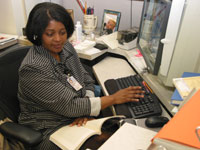
|
|
Crystal Smith inputs bibliographic data into a National Library of Medicine database.
|
My typical workday in the History of Medicine Division (HMD) of NLM consists of several major tasks:
- Creating bibliographic records - typing the details of journal articles into our historical database. Details include the author’s name, journal title, article title, volume and page numbers, language, abstracts if available, and more. In this case, we are focused on articles related to the history of medicine. (This database feeds into the PubMed database.)
- Cataloging specific chapters from books that are related to the history of medicine - typing information into another database called LOCATORplus (http://locatorplus.gov/). This database includes over 800,000 catalog records for books, audiovisuals, journals, computer files, and other materials in the Library's collections.
- Providing reference services in-person, by e-mail, phone, and letter to HMD researchers seeking access to HMD’s collection of rare materials including pre-1914 monographs, pre-1871 journals, pamphlets, prints and photographs, dissertations and a wide range of manuscripts and historical audiovisuals. I instruct customers in the use of the HMD and NLM databases, and explain HMD procedures relating to all aspects of library services and collection access.
- Updating the Directory of History of Medicine Collections http://www.nlm.nih.gov/hmd/directory/index.html, electronic and print versions, on a yearly basis and promoting new History of Medicine Collections (both nationally and internationally) to be added to the directory.
- Representing the reference staff by serving as a liaison between the Prints & Photos and the Historical Audiovisual sections of HMD.
- Working with onsite photographer, conservation librarian, and conservator to complete photography orders of picture requests from rare books in the HMD collection.
|
|
4. What I like best and least about my work is…
|
Back to Top

|
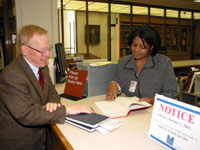
|
|
Crystal Smith helps a National Library of Medicine customer at the reference desk.
|
What I like best about my work is interacting with people. I also enjoy tracking down information to answer questions. I feel instant gratification when I find the answers to customers’ inquiries.
What I like least about my work is when I have to do a lot of typing as part of my technical duties.
|
|
5. My career goals are...
|
Back to Top

|
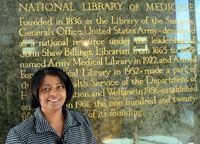
|
|
Crystal Smith stands in front of the National Library of Medicine.
|
My career goal is to become a reference librarian. I just graduated from my master’s program, so now I qualify for this position. I plan to apply for the position at NLM when it becomes available.
Update: Between the time of this interview and it’s posting on this Web site, Ms. Smith applied for a reference librarian position at NLM. She was subsequently hired for the position and now works at the reference desk in the History of Medicine Division.
My goal has finally been realized. It has been a long-term process, but I have a wonderful feeling of accomplishment. As a reference librarian, I assist NLM patrons in accessing the materials they need. I instruct them on the use of our reference databases, and answer their questions by telephone, email, letter, or face-to- face when they visit the library.
|
|
6. When I'm not working, I like to...
|
Back to Top

|
|
|
When I’m not working, I like to read historical fiction and listen to oldie’s music from the 70’s. I enjoy spending time with my daughter and new grandson as well.
|
|
|
|
 |